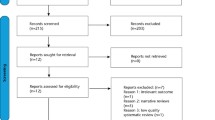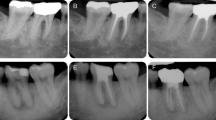Abstract
Data sources
Searches of Cochrane Central Register of Controlled Trials (CENTRAL), Medline, Embase, six thesis databases (Networked Digital Library of Theses and Dissertations, Proquest Digital Dissertations, OAIster, Index to Theses, Australian Digital Thesis program and Dissertation.com) and one conference report database (BIOSIS Previews) were undertaken. There were no language restrictions.
Study selection
Studies were included in which participants had a noncontributory medical history, presented with mature teeth and radiographic evidence of periapical bone loss (as an indication of pre-operative canal infection), whose selected root canals had not previously received any endodontic treatment, and who had undergone nonsurgical root canal treatment during the study in which calcium hydroxide had also been used to seal in the canals. In addition, it was required that microbiological sampling had been undertaken during the course of treatment, before canal preparation, after canal preparation and after canal medication. Aerobic and anaerobic culturing techniques were performed on all samples. The treatment outcomes were stated in terms of positive and negative canal cultures.
Data extraction and synthesis
All data were extracted in the same manner using a standardised data extraction sheet. Between-study heterogeneity was assessed using the standard chi-squared test or Q-statistic. The principal measure of treatment effect (antibacterial efficacy) was risk difference, which is normally defined as the risk in the experimental group minus risk in the control group. For the purpose of this study, it is given as the difference in the proportion of bacteria-positive cultures pre- and post-medication.
Results
Out of the eight studies (257 cases) included, one study used a small control group (in which canals were left empty, and no intracanal medicament was used between appointments). The other seven studies simply compared the frequency of positive cultures before and after calcium hydroxide medication. Six studies demonstrated a statistically significant difference between pre- and postmedicated canals, whereas two did not. There was considerable heterogeneity among studies. The pooled risk difference was 21% (95% confidence intervals, 6–47%. The difference in the proportion of cases positive for bacteria before and after treatment was not statistically significant (P = 0.12).
Conclusions
Based on the current best available evidence, calcium hydroxide has limited effectiveness in eliminating bacteria from human root canals, when assessed by culture techniques. The quest for better antibacterial protocols and sampling techniques must continue to ensure that bacteria can be reliably eradicated prior to obturation.
Similar content being viewed by others
Log in or create a free account to read this content
Gain free access to this article, as well as selected content from this journal and more on nature.com
or
References
Siqueira Jr JF, Goncalves RB . Antibacterial activities of root canal sealers against selected anaerobic bacteria. J Endodont 1996; 22:89–90
Bystrom A, Sundqvist G . The antibacterial action of sodium hypochlorite and EDTA in 60 cases of endodontic therapy. Int Endodont J 1985; 18:35–40
Orstavik D, Haapasalo M . Disinfection by endodontic irrigants and dressings of experimentally infected dentinal tubules. Endodont Dent Traumatol 1990; 6:142–149
Haapasalo HK, Siren EK, Waltimo TM, Orstavik D, Haapasalo MP . Inactivation of local root canal medicaments by dentine: an in vitro study. Int Endodont J 2000; 33:126–131
Cvek M, Hollender L, Nord CE . Treatment of non-vital permanent incisors with calcium hydroxide. VI. Clinical microbiological and radiological evaluation of treatment in one sitting of teeth with mature or immature root. Odontologisk Rev 1976; 27:93–108
Barbosa CAM, Goncalves RB, Siqueira JF, Uzeda M . Evaluation of the antibacterial activities of calcium hydroxide, chlorhexidine and camphorated paramonochlorophenol as intracanal medicament. A clinical and laboratory study. J Endodont 1997; 23:297–300
Author information
Authors and Affiliations
Additional information
Address for correspondence: Dr Chankhrit Sathorn, 720 Swanston Street, Melbourne, Victoria 3010, Australia. E-mail: chankhrit@gmail.com
Sathorn C, Parashos P, Messer H. Antibacterial efficacy of calcium hydroxide intracanal dressing: a systematic review and meta-analysis. Int Endodont J 2007; 40:2–10
Rights and permissions
About this article
Cite this article
Balto, K. Calcium hydroxide has limited effectiveness in eliminating bacteria from human root canal. Evid Based Dent 8, 15–16 (2007). https://doi.org/10.1038/sj.ebd.6400467
Published:
Issue date:
DOI: https://doi.org/10.1038/sj.ebd.6400467
This article is cited by
-
Preferences of dentists and endodontists, in Saudi Arabia, on management of necrotic pulp with acute apical abscess
BMC Oral Health (2018)
-
Trial suggests no difference between single-visit and two-visit root canal treatment
Evidence-Based Dentistry (2013)



